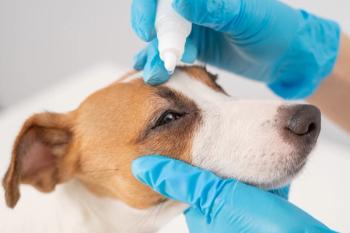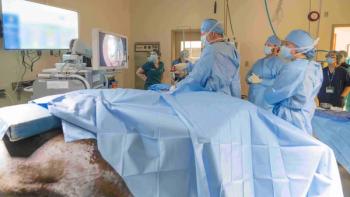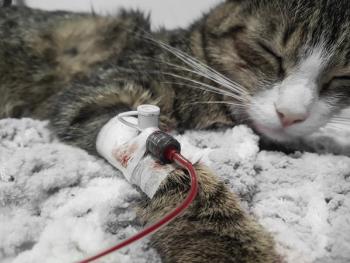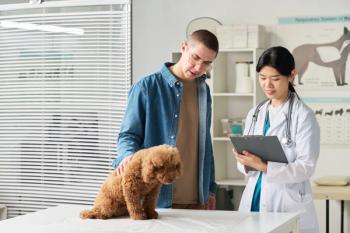
Skills Laboratory: Prolapsed third eyelid gland replacement
This modified Morgan pocket technique allows normal movement of the third eyelid postoperatively. Just follow these steps and achieve an optimal outcome.
A prolapsed gland is the most common disorder of the third eyelid in dogs. It is commonly referred to as a cherry eye because the prolapsed gland appears as a red mass that protrudes from behind the third eyelid. Prolapsed gland of the third eyelid is more common in young dogs and is overrepresented in some breeds, including American cocker spaniels and English bulldogs.
The exact cause of this condition is unknown, but it is thought to be due to a weakness of the tissues that normally anchor the gland to the periorbita. The condition may be unilateral but is often bilateral, with the glands prolapsing at different times.
Treatment pointers
The gland of the third eyelid produces a large portion of the aqueous tear film, about 30% to 40%. It is important not to excise or partially amputate the prolapsed gland because this may predispose the dog to the development of keratoconjunctivitis sicca later in life. The breeds that are more likely to develop a prolapsed gland of the third eyelid are also the same breeds that are more likely to develop keratoconjunctivitis sicca. Therefore, even with successful replacement of the gland, the Schirmer tear test should be monitored for life in all affected dogs.
Several surgical procedures have been described to reposition the gland and are generally divided into anchor and pocket techniques. The technique described here is a modified Morgan pocket technique. In the original conjunctival pocket technique, a conjunctivectomy is performed and the suture knots are buried, but in this procedure the conjunctivectomy is eliminated and the knots are placed on the anterior surface of the third eyelid to prevent possible trauma to the cornea.
The advantage of the modified Morgan pocket technique is that it allows the third eyelid to move normally postoperatively, whereas some of the tacking procedures restrict the movement of the third eyelid because it is anchored to a rectus muscle or the periorbital tissue of the orbital rim. If the third eyelid is unable to move normally, it may decrease its ability to protect the cornea and spread the precorneal tear film.
Recurrence of the condition is possible even when the surgery has been performed properly, especially in large- or giant-breed dogs.
Note that some veterinarians recommend using a topical corticosteroid preoperatively to reduce the inflammation and swelling of the gland. In general, I do not recommend the use of a topical corticosteroid either preoperatively or postoperatively because I am concerned that it may delay healing of the incision site.
Click next to read a step-by-step guide to this procedure.
Supplies
• Two Graefe fixation forceps or mosquito hemostats
• Eyelid speculum
• Bard-Parker blade handle and No. 15 blade
• Bishop-Harmon forceps
• Stevens tenotomy scissors
• Castroviejo needle holders
• 5-0 or 6-0 polyglactin 910 suture
Step 1
Place the dog in sternal recumbency. After preparing the eye with a dilute povidone-iodine solution (1:50 dilution) and rinsing the eye with sterile saline or eye wash solution, place an eyelid speculum to retract the eyelids. Place Graefe fixation forceps or nonabsorbable stay sutures at the medial and lateral edges of the third eyelid, and evert the third eyelid so the bulbar conjunctival surface is exposed.
Step 2
Make a curvilinear incision distal to (see illustration above) and proximal to (see illustration below) the prolapsed gland with a No. 15 blade, but do not connect the incisions. There should be a small opening medially and laterally to allow for tears to flow out of the pocket. The smaller illustration below shows where the incisions should be.
Step 3
Using Bishop Harmon forceps, grasp the edge of the distal conjunctival incision and, with tenotomy scissors, carefully elevate the bulbar conjunctiva from the underlying tissue toward the leading margin of the third eyelid to facilitate suturing the incision.
Step 4
Create a pocket in the proximal portion of the third eyelid with tenotomy scissors. The pocket should be large enough that the gland can be easily placed in it before closing the incisions.
Step 5
Tie an anchoring knot (5-0 or 6-0 absorbable suture such as polyglactin 910) on the anterior surface of the third eyelid (
see illustrations above
), and pass the suture through to the posterior surface (
see illustration below
).
Step 6
Suture the outer incisions together in a simple continuous pattern starting at either the medial or lateral extent of the bulbar conjunctival incision. Leave an opening both medially and laterally to prevent cyst formation and allow for tear drainage. (Some surgeons advocate an inverting pattern be placed, such as a Cushing pattern, after the initial simple continuous pattern.)
Step 7
After reaching the opposite end of the incision, pass the needle through the third eyelid, and place an anchoring knot on the anterior surface of the third eyelid to prevent the suture from contacting the cornea. If an inverting suture pattern is also placed, the knots should be secured on the anterior surface of the third eyelid.
Postoperative care
After surgery, administer a broad-spectrum topical ophthalmic antibiotic medication (e.g. neomycin, polymyxin B, and bacitracin ophthalmic ointment or neomycin, polymyxin B, and gramicidin ophthalmic solution) three to four times a day for seven to 14 days and an oral nonsteroidal anti-inflammatory medication for a few days.
Most dogs do not need an Elizabethan collar postoperatively, but if the patient rubs at the eye or appears uncomfortable, an Elizabethan collar should be worn for seven to 14 days. The sutures do not need to be removed, and the incision usually heals within two weeks.
Newsletter
From exam room tips to practice management insights, get trusted veterinary news delivered straight to your inbox—subscribe to dvm360.




